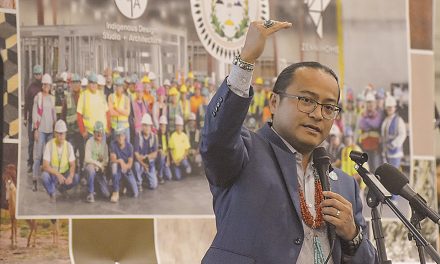
50 Years Ago | Forced relocation ends Navajo-Hopi land fight
The situation between the Hopis and the Navajos over 1.8 million acres of disputed land in the western portion of the Navajo Reservation continued with non-Indian Hopi rangers impounding Navajo sheep almost on a daily basis with the occasional arrest of Navajo livestock owners who “trespassed” on Hopi land to move their sheep back to Navajo lands.
During this time, I was writing two or three stories a week about the ongoing tension between the two tribes. Navajo leaders were bringing in residents of Big Mountain and other Navajo communities within the disputed area to talk to the media.
Howard Graves, an Associated Press reporter stationed in Albuquerque, made several trips to Window Rock to attend press conferences held by Navajo Tribal Chairman Peter MacDonald during which one of these community residents would be available to talk to the press.
I believed all of the current tension was created by the two tribes to force Congress or the courts to do something to resolve this long-standing dispute before someone was harmed or killed.
When I interviewed MacDonald, he expressed the same opinion when it came to Hopi actions and Hopi Tribal Chairman Clarence Hamilton said the same thing about Navajo leaders.
As for Navajo families living in the disputed area, their main fear was being forced to relocate although people like U.S. Senator Barry Goldwater held meetings in the disputed lands telling them that forced relocation would not happen.
MacDonald was continuing to speak out for continued negotiations between the two tribes and federal officials held the position that any negotiated solution would be acceptable to Congress.
I eventually came to the conclusion that while Hamilton and other Hopi leaders were going along with the idea of a negotiated settlement in public, the reality was that the two tribes were so far apart in their positions on the land dispute that the chance of a negotiated settlement was slim to none.
There was a negotiated meeting held about every three or four months. While both tribes agreed to hold the sessions behind closed doors and not to talk to reporters about what was said, I was usually able to find out what was said within a couple of days of the meeting.
The Hopis were incensed when these stories appeared in the press because they thought the Navajos were talking in an effort to gain support from the news media.
Hamilton issued several press releases blasting Navajo leaders for talking to me and in one case, they canceled one of the negotiating sessions after I wrote a story that it was going to happen on a certain date at a certain location which enabled militant factions to appear at the site to demonstrate on behalf of the Navajo families.
I remember a couple of occasions when Hopi leaders called me up in an effort to find out which Navajo leader was breaking the agreement to keep the talks secret but I refused to tell them anything.
I guess enough time has gone by to explain where I received most of my information. My sources were members of the Big Mountain community who had lost any hope that their leaders would be able to convince the Hopis to allow them to stay on their homelands.
MacDonald was a big believer in keeping these communities informed about what was going on to the point he usually came to meetings with them after meeting with the Hopis to give them current information.
I was the focus of so much criticism from the Hopis for the stories I was writing for the Navajo Times that I began to feel that my stories were hurting the chances for an agreement that at one point I had decided to stop writing about the land dispute to see what happened.
When I told this to George Vlassis, general counsel to MacDonald, he said I was putting too much credence to what Hamilton was saying.
“If you stopped writing about the land dispute, the Hopis would just come up with some other excuse to blame on for the failure of the talks,” he said.
Two years later, what the Navajos living in the disputed area feared came to be. Congress passed the Hopi-Navajo Land Settlement Act, which, among other things, created the Navajo-Hopi Indian Relocation Office with the main goal of relocating Navajo families and a few Hopi families living in disputed areas.
This led to the relocation of Navajo families at an eventual cost of tens of millions of dollars to the federal government.
At first, the act provided for Navajo families to move voluntarily, giving them enough money to buy a new home and, if possible, to continue to work with livestock.
This still provided me and other reporters a lot of opportunity to write about the unfairness of the settlement to Navajos with stories of families who had lived for generations on homelands now being forced to relocate to places where they could no longer carry on their traditions.
From 1974 through the ’80s, I wrote a number of articles telling the story of how relocation affects Navajo elders who moved to a new home. A study was done that showed relocation caused extreme stress to elderly inhabitants, in many cases resulting in an early death.
Eventually, some 34 years later, the two tribes would reach an agreement that would allow Navajo families to stay on their homelands, although with restrictions to prevent other Navajo families from moving onto lands that were awarded to the Hopis.
In hindsight, this arrangement should have been put in place in 1972, saving the federal government tens of millions of dollars and ending the anguish for thousands of Navajo families who had to face a future of forced relocation.








 Highway 264,
Highway 264, I-40, WB @ Winslow
I-40, WB @ Winslow